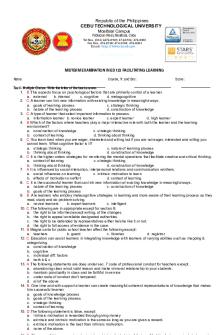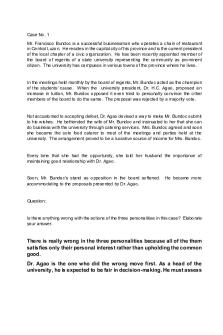Inbound 6934179760980964458 PDF

| Title | Inbound 6934179760980964458 |
|---|---|
| Course | Bs accountancy |
| Institution | Rizal Technological University |
| Pages | 8 |
| File Size | 143.6 KB |
| File Type | |
| Total Downloads | 71 |
| Total Views | 116 |
Summary
Review...
Description
Tutorial 7 Chapter 15: Cash Conversion Cycle The cash conversion cycle (CCC) is the length of time required for a company to convert cash invested in its operations to cash received as a result of its operations. •
A firm’s operating cycle (OC) is the time from the beginning of the production process to collection of cash from the sale of the finished product. It is measured by summing the average age of inventory (AAI) and the average collection period (ACP). OC = AAI + ACP
•
The time it takes to pay the accounts payable, measured in days, is the average payment period (APP). The operating cycle less the average payment period yields the cash conversion cycle. The formula for the cash conversion cycle is: CCC = OC – APP
CCC=Inventory Conversion period+ Receivables collection period-Payables Deferral Period CCC= (Days per year/inventory turnover) +Days sales outstanding- Payables deferral period Substituting for OC, we can see that the cash conversion cycle has three main components, as shown in the following equation: (1) average age of the inventory, (2) average collection period, and (3) average payment period. CCC = AAI + ACP – APP Questions:
1. A firm has an operating cycle of 120 days, an average collection period of 40 days, and an average payment period of 30 days. The firm's average age of inventory is ________ days. A) 80 B) 50 C) 90 D) 70 Answer: A 2. A firm has a cash conversion cycle of 80 days, an average collection period of 25 days, and an average age of inventory of 70 days. Its operating cycle is ________ days. A) 95 B) 105 C) 60 D) 130
Answer: A 3. A firm has an average age of inventory of 60 days, an average collection period of 45 days, and an average payment period of 30 days. The firm's cash conversion cycle is ________ days. A) 15 B) 45 C) 75 D) 135 Answer: C 4. A firm has a cash conversion cycle of 120 days, an average collection period of 25 days, and an average payment period of 50 days. The firm's average age of inventory is ________ days. A) 45 B) 95 C) 125 D) 145 Answer: D
5. A firm purchased raw materials on account and paid for them within 30 days. The raw materials were used in manufacturing a finished good sold on account 100 days after the raw materials were purchased. The customer paid for the finished good 60 days later. The firm's cash conversion cycle is ________ days. A) 10 B) 70 C) 130 D) 190 Answer: C 6. A firm has an average age of inventory of 101 days, an average collection period of 49 days, and an average payment period of 60 days. The firm's cash conversion cycle is A) 150 days. B) 90 days. C) 112 days. D) 8 days. Answer: B
7. A firm has an average age of inventory of 20 days, an average collection period of 30 days, and an average payment period of 60 days. The firm's cash conversion cycle is ________ days. A) 70 B) 50 C) -10 D) 110 Answer: C Topic: Cash Conversion Cycle Question Status: Revised AACSB Guidelines: Analytic skills
8. A firm has a cash conversion cycle of 60 days and average collection period of 40 days. The firm's operating cycle is ________ days. A) 20 B) 100 C) 50 D) cannot be determined Answer: D Topic: Operating Cycle Question Status: Revised AACSB Guidelines: Analytic skills 9. A firm has an average age of inventory of 101 days, an average collection period of 49 days, and an average payment period of 60 days. The firm's inventory turnover is ________. A) 3.2 B) 4.0 C) 2.5 D) 3.6 Answer: D
10. Carroll & King Corporation has $5 million of inventory and $2 million of accounts receivable. Its average daily sales are $120,000. The company’s payables deferral period (accounts payable divided by daily purchases) is 30 days. What is C&K’s cash conversion cycle?
a. 24 b. 26 c. 27 d. 28 e. 30
11. Westley Company’s average age of accounts receivable is 50 days, the average age of accounts payable is 45 days, and the average age of inventory is 72 days. Assuming a 365-day year, what is the length of its cash conversion cycle?
a. 66 b. 69 c. 73 d. 77 e. 81
12. Cyree Inc. has annual sales of $80,000,000; its average inventory is $20,000,000; and its average accounts receivable is $16,000,000. The firm buys all raw materials on terms of net 35 days, and it pays on time. The firm is searching for ways to shorten the cash conversion cycle. If sales can be maintained at existing levels while lowering inventory by $4,000,000 and accounts receivable by $2,000,000, by how many days would the cash conversion cycle be changed? Use a 365-day year.
a. -27.4 b. -28.7 c. -30.2 d. -31.7 e. -33.3
Steps: Inventory conversion period= (Days per year)/ (Sales/Inventory) Days receivables are outstanding= (receivables)/(Sales/365) Payables deferral period
CCC1 91.25
CCC2 73
73
63.875
35 days 129.3 Then change in CCC= 101.9-129.3=-27.4
35 days 101.9
13. Carroll & King Corporation has $5 million of inventory and $2 million of accounts receivable. Its average daily sales are $120,000. The company’s payables deferral period (accounts payable divided by daily purchases) is 30 days. What is C&K’s cash conversion cycle?
a. 24 b. 26 c. 27 d. 28 e. 30
14. Margetis Inc. carries an average inventory of $1,000,000. Its annual sales are $10 million, and its receivables conversion period is twice as long as its inventory conversion period. The firm buys on terms of net 30 days, and it pays on time. Its new CFO wants to decrease the cash conversion cycle by 10 days, based on a 365-day year. He believes he can reduce the average inventory to $863,000 with no affect on sales. By how much must the firm also reduce its accounts receivable to meet its goal of a 10-day reduction in the cash conversion cycle?
a. $0 b. $101,900 c. $136,986 d. $333,520 e. $1,000,000 Steps: CCC= inventory conversion period+ days sales outstanding+ payables deferral period Before reduction in CCC After reduction in CCC Sales 10,000,000 10,000,000 Inventory 1,000,000 863,000 Receivables conversion =2*inventory conversion period period Payables deferral period 30 days 30 days So CCC before reduction= (365)/( 10,000,000/1,000,000)+2*(365)/( 10,000,000/1,000,000)-30=79.5 Then: days sales outstanding= (receivables)/(sales/365)=2* (365)/( 10,000,000/1,000,000)= 73 then receivables before the reduction= 2,000,000 CCC after reduction= 69.5 69.5= (365)/( 10,000,000/863,000)+ Receivables/(10,000,000/365)-30 Then receivables after reduction= 1,863,013.68 Then receivables should be reduced by 2,000,000-1,863,013.68=136,986.32...
Similar Free PDFs

Inbound 6934179760980964458
- 8 Pages

Inbound 9062323683313587336
- 8 Pages

Inbound 5823373113343837658
- 7 Pages

Inbound 8992858066865085290
- 35 Pages

Inbound 1325070542858891916
- 28 Pages

Inbound 8120283391829648951
- 6 Pages

Inbound 6016901228306107183
- 9 Pages

Inbound 2127717059
- 2 Pages

Inbound 177382260363055158
- 17 Pages

Inbound 728676790794323547
- 4 Pages

Inbound 8111161337146048105
- 15 Pages

Inbound 320506396223752749
- 13 Pages

Inbound 2570237734164090433
- 30 Pages

Inbound 8069741523876833130
- 53 Pages

Inbound 1326087921954880360
- 18 Pages

Inbound 1582835701478571632
- 47 Pages
Popular Institutions
- Tinajero National High School - Annex
- Politeknik Caltex Riau
- Yokohama City University
- SGT University
- University of Al-Qadisiyah
- Divine Word College of Vigan
- Techniek College Rotterdam
- Universidade de Santiago
- Universiti Teknologi MARA Cawangan Johor Kampus Pasir Gudang
- Poltekkes Kemenkes Yogyakarta
- Baguio City National High School
- Colegio san marcos
- preparatoria uno
- Centro de Bachillerato Tecnológico Industrial y de Servicios No. 107
- Dalian Maritime University
- Quang Trung Secondary School
- Colegio Tecnológico en Informática
- Corporación Regional de Educación Superior
- Grupo CEDVA
- Dar Al Uloom University
- Centro de Estudios Preuniversitarios de la Universidad Nacional de Ingeniería
- 上智大学
- Aakash International School, Nuna Majara
- San Felipe Neri Catholic School
- Kang Chiao International School - New Taipei City
- Misamis Occidental National High School
- Institución Educativa Escuela Normal Juan Ladrilleros
- Kolehiyo ng Pantukan
- Batanes State College
- Instituto Continental
- Sekolah Menengah Kejuruan Kesehatan Kaltara (Tarakan)
- Colegio de La Inmaculada Concepcion - Cebu